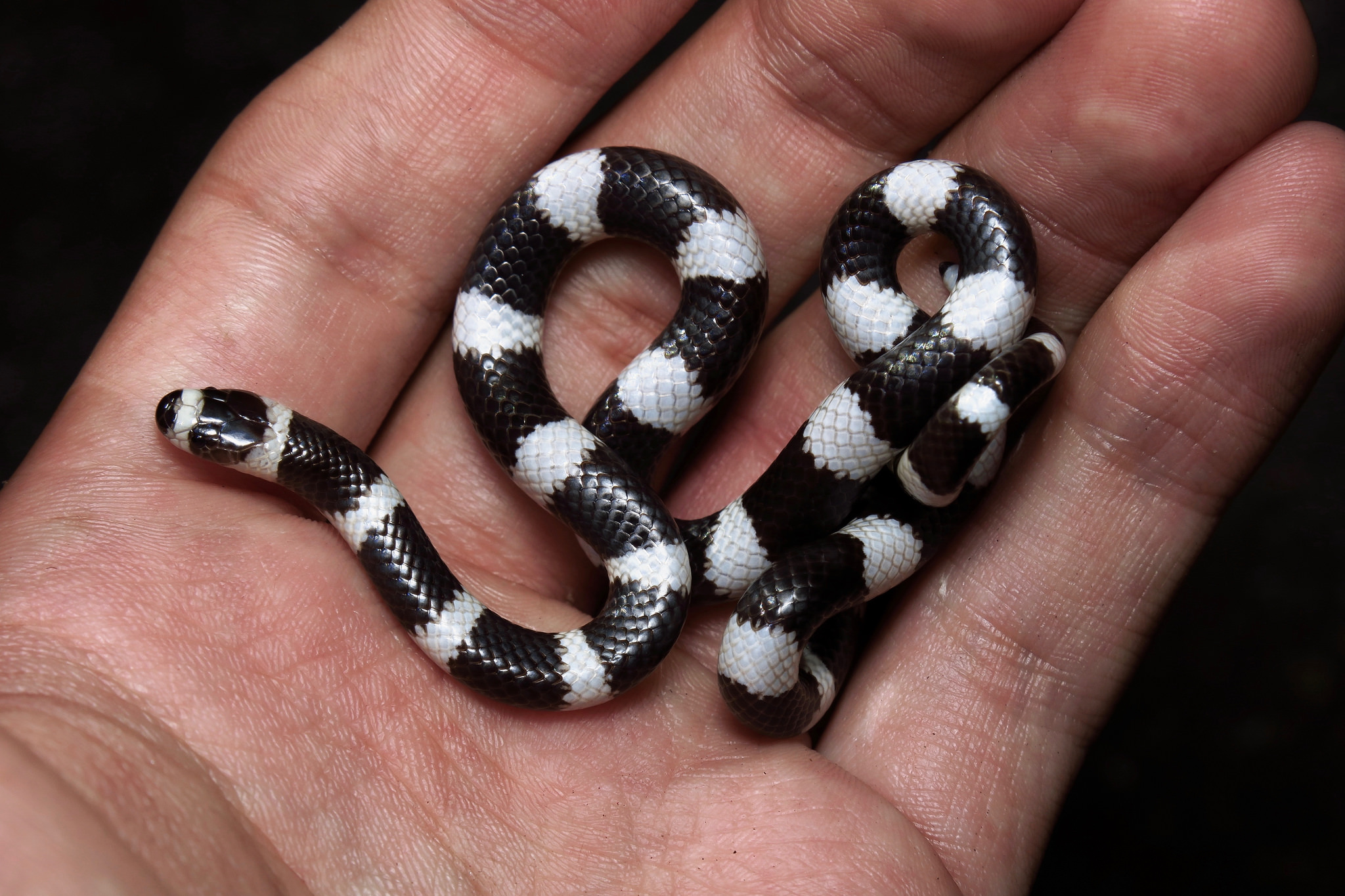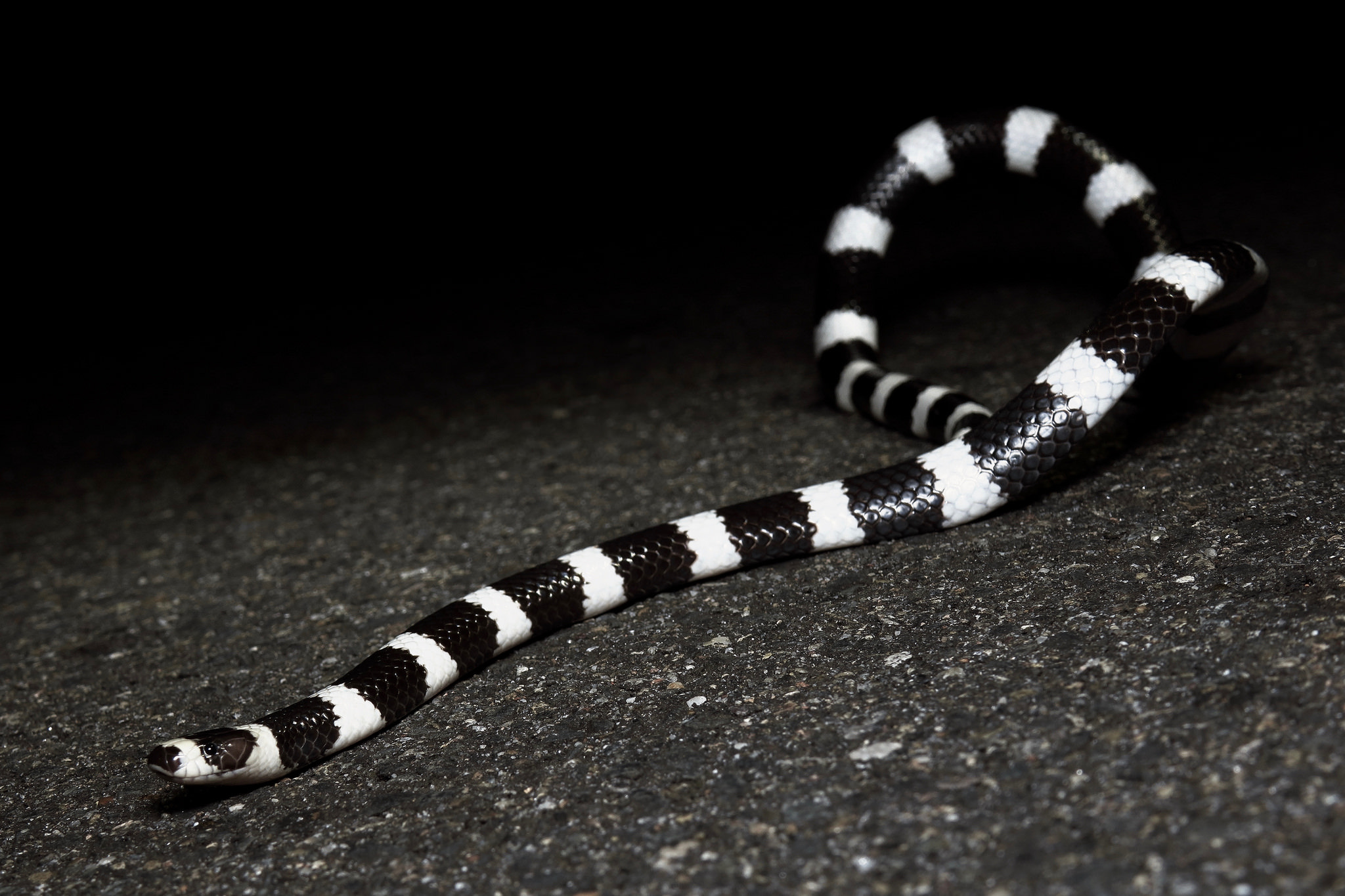
This October in NSW it is drier and colder than it was in previous years. We kept our eyes out for creatures like death adders (Acanthophis antarcticus) and pymgy-possums (Cercartetus nanus) that might be crossing the road at night. For a couple of hours there was nothing to be found, but after seeing a few swamp wallabies (Wallabia bicolor), we found our first snake— a Bandy-bandy (Vermicella annulata). Australia has great nicknames for pretty much everything, and I now see that their endearing phrases extend to common names of animals as well (e.g. blueys, frillys, hmm… are brown snakes called brownies?). Surely in the New World this snake would have been named something like the black and white snake-eater (you’ll see why I say snake-eater if you keep reading this blog post). I was amazed that my friend James managed to spot this snake while barreling down the road at 60 km per hour. The snake was thin and about 20 centimeters long. In fact, when I jumped out of the car expecting to see a snake, my eyes gazed up the road in search of a thicker-bodied outline.


The Bandy-bandy (Vermicella annulata) is a venomous snake in the family Elapidae, but its fossorial nature and reliance on its threat display for predator deterrence make it an exception to the rule for “freehandling” an venomous snake. In other words, their defensive behavior does not involve biting. Bandy-bandys are most closely related to the genus Neelaps, followed by the Oxyuranus–Pseudonaja clade (taipans and brown snakes). There are six recognized species in the genus Vermicella, all of which are fossorial and nocturnal, and analyses of stomach contents suggest that they solely feed on blind snakes of the genus Ramphotyphlops.

The conspicuous banded coloration is likely aposematic, as in most coral snakes and kraits. However, when the snake is in motion, the patterning serves a flicker-fusion effect, where a high contrast pattern becomes blurred when moving at high speeds. I have observed this in fleeing coral snakes Micrurus alleni (classic red/yellow/black) in the Atlantic rainforests of Costa Rica and Micrurus hemprichii (black/yellow/white) in the Brazilian Amazon. Not only is it hard to tell where the head of the snake has gone, the pattern transitions from a conspicuous to an inconspicuous state, leaving a predator such as myself seeking the original vibrant contrasting pattern. This deception in search image corroborates the flicker-fusion hypothesis as a cryptic strategy. Similar antipredator strategies such as flash colorations in Morpho butterflies and possibly red-eyed tree frogs (Agalychnis callidryas) provide different, though analogous, examples of how aposematic colorations can play a role in crypsis. This can be seen as an analogous strategy to deimatic displays where an animal transitions from an inconspicuous to a conspicuous state to trigger a sensory overload in a predator. Through employing a deimatic display, the performer is given a better chance of escaping while the predator hesitates, and in some cases the performer can even intimidate the predator into a full retreat. This antipredator strategy is exactly what I will be looking at in my research on frilled lizards (Chlamydosaurus kingii) in the Northern Territory of Australia in one week.
Although some readers may cringe at the thought of aposematism as a cryptic antipredator strategy, I consider the transition to a state less discernable from the substrate to be a form of crypsis— just as a mimic octopus changes color pattern and texture for camouflage.

Speaking of deimatic displays, the Bandy-bandy also has a threat display! In contrast to coral snakes, which often raise and curl their tails into a spiral accompanied by flattening base of the tail near the cloaca, the Bandy-bandy raises a substantial portion of the mid-section of the body up in the air. This has led to another common name for this species – the hoop snake. Indeed, as I saw part of the snake conform into a semi-elliptical shape, I couldn’t help but think of games I used to play as a child (and still play), where I throw a small object into an opening. While raising the body in a slow motion, the snake randomly flipped its body around with a motion similar to a firm rubber tube being shaken by the center. I focused on shooting stills of this beautiful snake as opposed to footage of the defensive display, but hopefully I will find another bandy-bandy and record the behavior soon.




This strange and unique behavior the Bandy-bandy exhibits when threatened was baffling to me, and I have not come up with a reasonable theory for why it may be an effective defensive display other than simply making the snake appear larger and more visibly demonstrating the aposematic pattern. Comment below if you have any theories about this bizarre behavior!

To finish this blog post, here’s one more photo of a bandy-bandy in the shape of a heart, moments before assuming its defensive posture. Sometimes reptiles do show the love back.


I like it